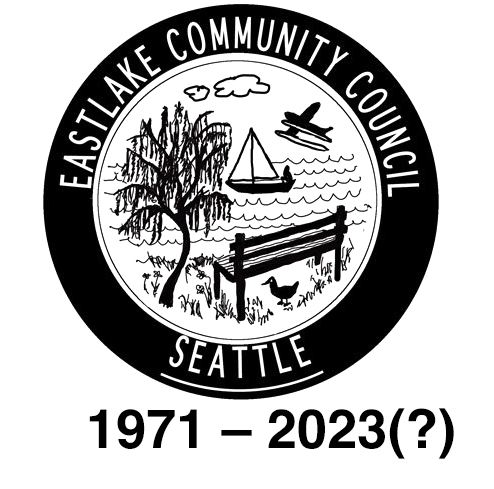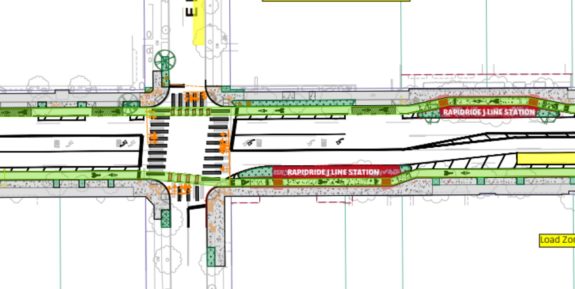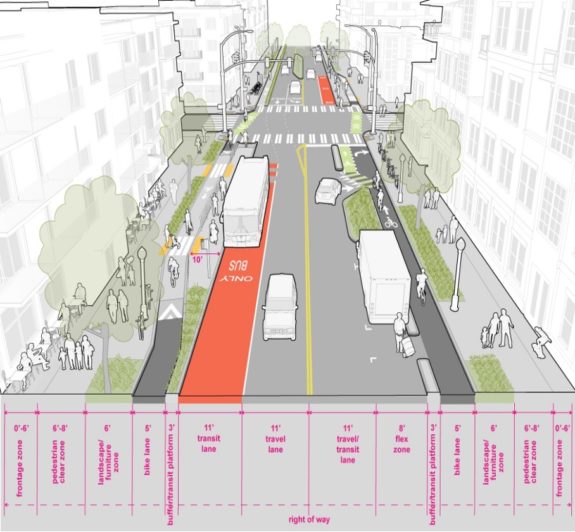Eastlake Community Council ousts 40% of their board members for supporting a bike lanes and transit project

The Eastlake Community Council last week voted 5-4 to kick those four members off the Board after they voiced support for a fully designed and funded bike lane and transit project ready to begin construction on Eastlake Avenue.
The act has sparked outrage and called into question the legitimacy of the organization, which has existed since 1971. Those removed include the only three renters on the Board as well as the three youngest members. Removing these volunteers for voicing a dissenting opinion is an extreme act that abandons the Council's standing and legacy as a democratic voice of the neighborhood.
ECC President Detra Segar told the Urbanist that the members were ousted because they had decided to undermine our efforts by sending a letter to some city leaders voicing their opposition." The ECC Board recently voted, again by a narrow margin, to send a poorly-written letter to city and regional leaders voicing opposition to the RapidRide J project, which is preparing to search for a contractor to begin construction. The four ousted members decided to send their own letter of dissent to city leaders in which they identified themselves as members of the Eastlake Community Council Board of Directors who disagree with the letter that was sent to you." They note that the official ECC letter was approved by a 6-4 vote and was in no way unanimous." The dissenting letter is entirely factual and does not misrepresent the writers as acting on behalf of the Council, acknowledging clearly in the opening paragraph that the other letter received the majority vote. The official letter, in contrast, does not note the vote count or acknowledge that there was any dissent among the board members. You can read both letters in full at the bottom of this story.
Segar, meanwhile, has a history of making unhinged negative statements about people who ride bikes. As Ryan Packer reported for the Urbanist, Segar penned a 2022 letter then-new SDOT Director Greg Spotts in which she wrote, The Move Seattle vision seems to only see able-bodied peak hour commuters pedaling along arterials pretending to be the equals of buses and cars." It seems she feels that people biking don't belong on her streets, and people who support bike lanes don't belong on her Council. Unfortunately for Segar, the streets belong to everyone. Likewise, the Eastlake Community Council is supposed to belong to the whole neighborhood, which includes a lot of people who ride bikes.
Despite the confusing assertion in Segar's letter that the opening of U District Station has made the project outdated" and redundant," the RapidRide J project was created specifically to improve access to these new light rail stations. After all, a train traveling underground deep inside Capitol Hill does not serve the Eastlake neighborhood. The improved bus and bike lanes are designed to help people in Eastlake get to and from the quality transit service downtown and in the U District.
Segar's letter also tries to argue that the city shouldn't build the transit and bike improvements for equity's sake, urging leaders to explore alternative uses of the Rapid Ride J funds that could address pressing equity concerns in less advantaged areas of Seattle, and/or fill the gap on projects that would help to revitalize downtown." But then she immediately tells on herself by saying, What we do need is a resurfaced Eastlake Ave and the 50 year old water line replaced." These are two of the biggest costs of the whole project. So she does want the bulk of the money to be invested in Eastlake, but they can send the buses and bike lanes that she doesn't want to the less advantaged areas."
Regardless, that's not how Federal grants work. The project's significant Federal funding cannot simply be transferred to other projects. This one was chosen through a competitive grant selection process based on its promising ridership projections and the role it will play in better connecting people to other major transit improvements.
Cascade Bicycle Club has created a handy online form that anyone who lives in District 3 can use to send both candidates a letter showing support for the project, which has been studied for a decade. The city even created an entire study dedicated solely to determining whether there were any potential bicycling alternatives and came up empty.
I read through the Council's bylaws, and the dissenting members did not break any of the rules outlined within it. Likewise, the bylaws allow removal of members by a majority vote without cause." The remaining Board members seem to have the choice to either continue as a six-person Board or to select replacements without a vote of the members. The remaining members also have the power to choose when the next Board election will be. There is a provision that says members having ten percent of the votes entitled to be cast as such a meeting" have the power to call a special meeting even if the ECC Board does not want one. I'm no lawyer, but that seems to be the only release valve built into the Council's bylaws for dealing with a rogue Board like this one. In order to vote, someone would need to be a paying member in good standing for at least 30 days before the vote.
We'll see how the neighborhood responds after this. Will they try to elect more responsible Council stewards or will they turn their backs on it and let wallow in obscurity? Participating on a community council is a lot of volunteer work, which has always posed a major challenge to creating a truly representative and democratic body like this. Other community councils might want to worry that the ECC's non-democratic actions could do harm to the reputation of the concept of community councils in our city.
In the meantime and until changes are made to restore community trust, it is unfortunately prudent for media, city departments and city leaders to treat the Eastlake Community Council as a non-representative and non-democratic council.
Official ECC letterDissenting letterRe: Rapid Ride J Line - For Equity, relocate redundant J line dollars to South Seattle
Dear Mayor Harrell:
I am writing to you on behalf of the Eastlake Community Council to ask that you redirect the federal funding for the RR-J line to another more appropriate project in Seattle that would address fairness and equity.
We appreciate the effort that the RR-J team has made over the last few years.They have provided current information as it became available and worked collaboratively with us to address pedestrian and cyclist safety, negative impact on neighborhood businesses and the elimination of parking on Eastlake Ave.There have been revisions, compromises and adjustments.CM Pedersen, Transportation Chair, has been part of several of our meetings.Ultimately, the use of funds to build a project that is outdated and inappropriate for Eastlake Ave. is simply not a wise use of public funds.We understand that SDOT has limited power to reverse a decision by a previous administration.We need your support to reverse this now redundant project.
Specifically, the project is misaligned with both City and community goals in a number of significant ways:
1.The data which drove the Rapid Ride J line project is out of date. The opening of light rail at Roosevelt and the University District to downtown significantly affected commuting options.The Covid pandemic altered commuting patterns to downtown that we continue to assess.Those wanting fast service to downtown will choose light rail. There is uncertainty with the longevity of any transportation system so providing one with flexibility is important. The hardscape construction of the RR-J is expensive and leaves little room for adaptation.
The proposed design radically contradicts the recommended principles of neighborhoodstreet design as documented in the City of Seattle ROW manual, and the goals for the
Eastlake Urban Village as outlined in its neighborhood plan and the City of SeattleComprehensive Plan, introducing changes that would negatively impact ourneighborhood business district.
2.The safety of cyclists on a narrow street shared with Rapid Ride that also has turn lanes to support on and off access to I5 and several buildings with turn-in parking mid-block is a major concern. During peak traffic times, safety concerns will multiply and there will be nothing rapid about a Rapid Ride bus on Eastlake Ave.
3.From an equity standpoint, Federal resources which have been allocated to this project would be better used in neighborhoods which are not as well-served by existing transit resources. This would be consistent with King County's equitable decision to focus on other rapid lines in the region.
To elaborate:
The Rapid Ride J line project requires a comprehensive reassessment of its premises and objectives. The cost-benefit analysis which justified this project was completed prior to the opening of the Roosevelt and University District light rail stations in 2021 and the global outbreak of the COVID-19 pandemic. The first altered commuting options permanently and the second presented another reason for flexibility.
Furthermore, the proposed design violates several key principles that drive the street design goals illustrated in the City of Seattle Right of Way (ROW) manual. It is deeply concerning that the Rapid Ride J line project seeks a deviation that wouldshrink the width of the sidewalks adjacent to some proposed stations to less than 7.5 feet, which is below minimum standards for any city street, let alone a neighborhood main street. This falls significantly below the city code requirement of 12 feet.Note that this deviation also entails removing many existing mature street treesat a time when council has passed a new ordinance to protect our tree canopy.
By compromising our pedestrian space, we risk limiting the accessibility and safety of pedestrians, particularly those with mobility challenges or individuals who rely on strollers, wheelchairs, or other mobility aids.In addition, our local businesses rely heavily on pedestrian infrastructure for their success and such a deviation would be a fatal blow to many of our longest-tenured and most-loved businesses in Eastlake.
The following diagram shows SDOT's proposed RR-J design at Eastlake Avenue and Lynn Street, which is effectively the Main & Main" of the Eastlake Urban Village. The shadowed outlines show where existing curb lines and trees would be removed.Please compare this to the next diagram which shows the City's own recommended design for Urban Village Main Streets.This design accommodates both bike lanes and bus service, while maintaining street trees, adequate sidewalks, seating areas for small business as well as loading and parking in some locations.
Rapid Ride J Street Design Diagram - Eastlake & Lynn
[1]2.8 Urban Village Main," Seattle Right-of-Way Improvements Manual,Seattle.gov.
[2]Seattle Roadway Classification," City of Seattle GIS.
[3]Street Type Standards," Seattle Right-of-Way Improvements Manual,Seattle.gov.
Cross-Section View, Urban Village Main Street - Principal Arterial
Eastlake Avenue is designated an Urban Village Main Street with minimum widths of 6' for the pedestrian clear zone and 6' for the landscape/furniture zone (6' + 6' = 12' minimum) as depicted above.The Rapid Ride J project requires a reduction to 8.5' combined for these two zones. (Source: Seattle Right-Of-Way Improvements Manual
Additionally, we believe that the project's current design is misaligned with the City of Seattle Comprehensive Plan which recognizes Eastlake's status as a historically established neighborhood and an urban village and calls for Eastlake to increase the development of neighborhood-serving businesses at street-level".The Eastlake Community Council is currently working with OPCD to further clarify and elaborate on this goal to create the best possible environment for pedestrian-oriented small business.To be clear, Eastlake would welcome protected bicycle lanes and more frequent headways on the #70 bus line, to the extent achievable with our current infrastructure, but not if it comes at an existential cost to our small businessesand our pedestrian environment.
To summarize this point, a cycle thoroughfare and a bus rapid transit line don't belong in the same urban village main street because they simply don't fit and the deviant design is the result of this basic fact. What we do need is a resurfaced Eastlake Ave and the 50 year old water line replaced. We need safe bike lanes and an efficient bus service. The bus service need is currently being met by the #70 bus.
Lastly, we question the allocation of budgetary resources to the Rapid Ride J line project,particularly in relation to consideration of need, fairness and equity. Our neighborhood is being asked to accept a questionable design and now unnecessary Rapid Ride project while many neighborhoods are in need of more adequate transit service and federal funding to close their budget gaps. We use SDOT, in collaboration wiht the Federal Transit Authority, to explore alternative uses of the Rapid Ride J funds that could address pressing equity concerns in less advantaged areas of Seattle, and/or fill the gap on projects that would help to revitalize downtown.
We appreciate your attention to this matter and would welcome the opportunity to discuss our concerns further. We have more than fulfilled our obligations pursuant to the Comprehensive Plan by adding substantial housing density to the Eastlake neighborhood.With the Rapid Ride J line project, the City is reneging on its obligations to us for all the above-mentioned reasons. The Eastlake Community Council stands ready to collaborate with the City and SDOT to ensure that any transportation project in our community upholds the highest standards of safety, accessibility, and equity.
Thank you for your time and consideration.
Sincerely,
Detra Segar
President, Eastlake Community Council
We are members of the Eastlake Community Council Board of Directors who disagree with the letter that was sent to you on or about August 10 by our board president. The vote to approve the letter was a six to four vote, in no way unanimous.
The city's plan for Eastlake Ave. is a good one in the midst of competing priorities and difficult choices. Rapid Ride J-Line and protected bike lanes are needed as density in our urban village continues to grow.
The main issue for Eastlake business owners and residents is the loss of parking along Eastlake Ave. that these changes would bring. However, studies* have shown that removing parking for bike lanes has a neutral to positive effect on nearby businesses. Eastlake businesses will continue to flourish with the RapidRideJ project that will make the neighborhood safer and more pedestrian friendly. *Studies featured in 01/23/2023 WIRED article: The Battle Over Bike Lanes Needs a Mindset Shift.
Protected bike lanes along both sides of Eastlake Ave., fulfill a long-desired bikeway in the city's bike master plan that will promote and encourage sustainable travel such as bicycling, scootering, and skating in Eastlake and Seattle as whole. Eastlake Ave. is currently unsafe for bicyclists, and it is the most direct route for motorists and bicyclists alike. It is time we allow bicyclists the same direct route that motorists have long enjoyed.
The new rapid transit line and bicycle lanes will shift Eastlake Ave. from a car-centric corridor to a more walkable and pedestrian friendly corridor with priority given to traffic calming bicycle lanes and public transit.
While there may be room for further improvements and refinements, the plan is a positive shift that helps to address climate change while making Eastlake more livable.
Sincerely,
Judy Smith, Zach Wurtz, Kellie Seldon, Angela Shier

